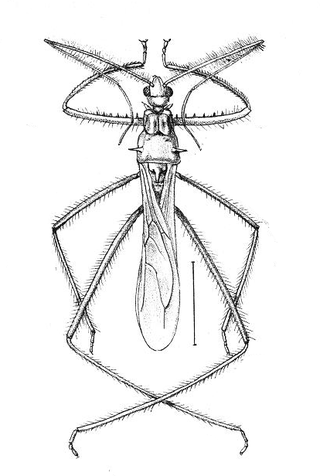
The Reduviidae is a large cosmopolitan family of the order Hemiptera. Among the Hemiptera and together with the Nabidae almost all species are terrestrial ambush predators; most other predatory Hemiptera are aquatic. The main examples of nonpredatory Reduviidae are some blood-sucking ectoparasites in the subfamily Triatominae. Though spectacular exceptions are known, most members of the family are fairly easily recognizable; they have a relatively narrow neck, sturdy build, and a formidable curved proboscis. Large specimens should be handled with caution, if at all, because they sometimes defend themselves with a very painful stab from the proboscis.

The Emesinae, or thread-legged bugs, are a subfamily of the Reduviidae. They are conspicuously different from the other reduviids by their very slender body form. They are stalking, predatory insects that can be collected on palm fronds, cliffs, spider webbing, or near lights at night. They walk on their mid and hind legs; the front pair is raptorial. Some groups specialize on spiders. Very little is known about emesines except that many species are found in the tropics. Pedro Wygodzinsky wrote the most recent revision of this group.

Berytidae is a family of the order Hemiptera, commonly called stilt bugs or thread bugs. Most berytids are brown to yellow, with species that are plant sap feeders, a few being predaceous. About 200 species are known from all around the world and they are classified into three subfamilies.
Ghilianella beckeri is a species of assassin bug in the subfamily Emesinae found in Brazil. The species was described in 2009 and was found in the collection of the late professor Johann Becker (1932–2004).
Ghilianella phasma is a species of assassin bug in the subfamily Emesinae. It is found on the Indian subcontinent and in Myanmar. There is some debate about whether this species may belong in the genus Schidium. William Lucas Distant placed the species in Ghilianella but Ernst Evald Bergroth and Pedro Wygodzinsky moved it to Schidium. In his 1990 work of the Reduviidae of the world, Moldonado doubted the Schidium placement.
Ghilianella borincana is a species of true bug found in semi-evergreen forest of Puerto Rico. It is highly cryptic, using catalepsis.
Ploiaria metapterina is a species of true bug found in SE Australia.
Stenolemus bituberus is a species of thread-legged insect (Emesinae) found across much of Australia. This species spends nearly its entire life in spider webs. It preys upon a variety of spiders, including webs and nests of spiders of Achaearanea, Badumna, Pholcus, and Stiphidion, and the families Salticidae and Uloboridae. This species is found in a broader diversity of spider webs than any other species in Stenolemus.
Gardena is a genus of thread-legged bugs in the subfamily Emesinae. It is the second-largest genus in the tribe Emesini. Presently there are 46 described species.
The Leistarchini is a tribe of thread-legged bugs.

Emesopsis is a genus of tropical bugs (Heteroptera) from the family Reduviidae. There are at least 22 described species, of which one, E. nubila, also occurs in southern Europe.
Bagauda is a genus of thread-legged bug in the Emesinae. 18 species are currently known. Many of the species of this genus are associated with caves, some exclusively so. Bagauda is synonymous with the genus Pleias Kirkaldy, 1901, but Bagauda has become more widely used. The genus is restricted to Old World tropics.
Chinemesa is a little-known genus of thread-legged bug (Emesinae) apparently endemic to Borneo. Only four species have been described and the three described by Wygodzinsky in 1966 have not been observed since.
Onychomesa is a little-known genus of thread-legged bug in the subfamily Emesinae. Three species have been described, one from India, Japan, and Taiwan.
Pseudobargylia is a little-known genus of thread-legged bug in the subfamily Emesinae. Species of this genus are not adapted for spiderwebs like some other members of the subfamily. Members of the genus occur in Tasmania and Australia. Tasmanian species of this genus are wingless, an unusual characteristic for true bugs.
Gardena insperata is a thread-legged bug species from the genus Gardena. It is found in Tajikistan and Afghanistan.
Saicella is a genus of assassin bugs endemic to Hawaii. There are currently six species in the genus. Saicella's taxonomic position is uncertain, with characters similar to both the Saicinae and Emesinae subfamilies.

Saicinae is a subfamily of the family Reduviidae, or the assassin bugs.
Bagauda zigzag is a species of assassin bug discovered in Taiwan in 2007 in an area of uplifted coral reef forest. One individual was observed to prey upon a spider. The species is nocturnal and individuals were most commonly found on Chinese banyan and King fig (Moraceae).
Borneodessus zetteli is a species of beetles in the family Dytiscidae, the only species in the genus Borneodessus.




